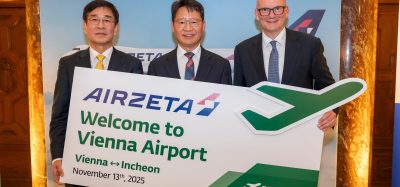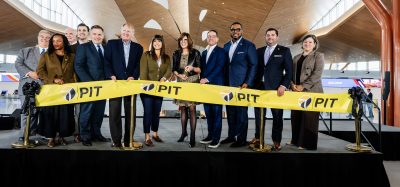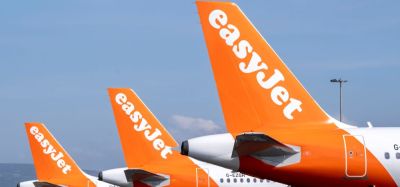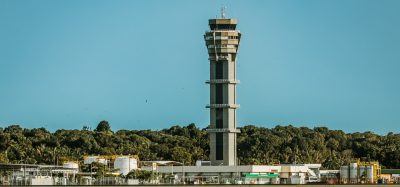Cleaner, Greener Airports: Making Aviation More Sustainable – San Francisco Airport
Posted: 9 July 2021 | Anthony Bernheim, Erin Cooke | No comments yet
San Francisco International Airport colleagues Erin Cooke, Sustainability and Environmental Policy Director, and Anthony Bernheim, Healthy & Resilient Buildings Program Manager – Planning, Design & Construction, explain the airport’s goals to become a ‘zero’ campus and the importance of sustainability in a region that is actively experiencing the effects of climate change in the latest instalment of International Airport Review’s exclusive series.
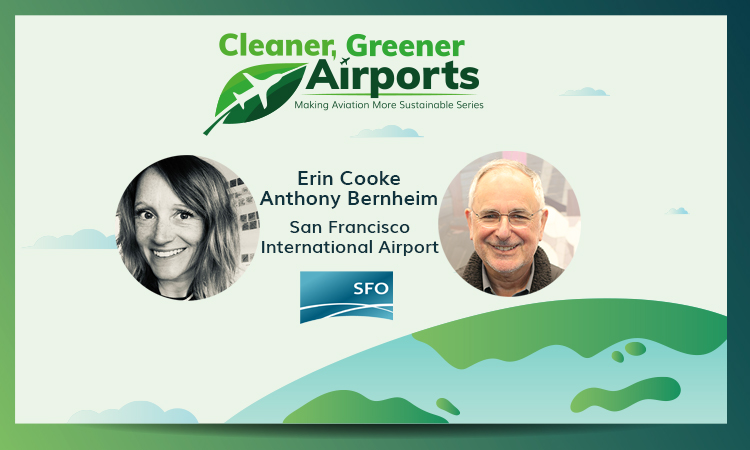

San Francisco International Airport (SFO) continues to advance its Strategic Plan Goal to become the world’s first net zero energy, net zero carbon and zero waste airport campus as a key tenant of its pandemic and economic recovery to resilience pathway. As an airport located in Northern California – a region within a state that continues to be one of the hardest hit by wildfires that are fuelled by our changing climate – we acknowledge that our ambitions of a ‘zero’ campus must be operationalised to recover and respond to the next climate hazard event and this current pandemic.
SFO’s mission is to provide an exceptional airport in service to our communities”
SFO’s mission is to provide an exceptional airport in service to our communities. In 2019, SFO welcomed nearly 58 million guests, 470,000 aircraft operations, half a million metric tonnes of cargo and supported 46,000 direct jobs and nearly $11 billion in local business activity. In 2020, passenger activity was down by over 70 per cent compared to 2019, and we now anticipate that it will take several years to return to pre-pandemic passenger levels.
Our airport is an enterprise department of the City and County of San Francisco, and it strives to be safe and on the leading edge for airport environmental and social sustainability initiatives, all while operating a successful and efficient business. These goals stand today, as SFO works to deliver its Strategic, Climate, Social Equity and Capital Plans, all under its new Recovery Framework.
Join our free webinar: Revolutionising India’s travel experience through the Digi Yatra biometric programme.
Air travel is booming, and airports worldwide need to move passengers faster and more efficiently. Join the Digi Yatra Foundation and IDEMIA to discover how this groundbreaking initiative has already enabled over 60 million seamless domestic journeys using biometric identity management.
Date: 16 Dec | Time: 09:00 GMT
rEGISTER NOW TO SECURE YOUR SPOT
Can’t attend live? No worries – register to receive the recording post-event.
Each of these plans recognise the parallel pandemic and climate change crises. Pandemic recovery cannot be a return to ‘business as usual’ when the world is expected to warm by 3℃, as this will cause future intensified natural disasters. It is hard to imagine that, during the pandemic in 2020, more than 4,600 firefighters simultaneously battled 22 active wildfires in California while SFO was operating an airport campus where nearly 50 per cent of its acreage is already under water.
Targeting zero, including tenants
Our Strategic Plan, still actively being implemented, is also our roadmap to accomplish our city’s sustainability ambitions”
Sustainability is foundational to the airport’s operations, and we align our goals with those set by our industry association, Airports Council International (ACI), and by SFO’s foresighted leadership that tasked SFO with achieving a new “moonshot” in 2015. Their goals were codified in our 2016 Strategic Plan to achieve ‘zero’: net zero carbon, net zero energy and zero waste. Our Strategic Plan, still actively being implemented, is also our roadmap to accomplish our city’s sustainability ambitions. While SFO’s sustainability goals directly impact the facilities and transportation systems under our direct operational control, we also prioritise initiatives to support the airport’s tenants to achieve deep sustainability achievements. Many of these tenants operate in high performance buildings with healthy environments, and the design, construction and operation of their spaces benefit from, and enhance, the base building performance.
We leverage our sphere of influence, acknowledging that the number one commitment that we can make to mitigate and pivot this projected future is to accelerate the transition away from conventional carbon-intensive fuels for buildings and all transport modes, including aircraft, and move our sector forward in its ambition to achieve a low carbon future. Our airlines, concessionaires and fixed base operators (FBOs) are essential partners in advancing energy and waste reductions and key emissions mitigations across our supply chain, as they represent 99 per cent of emissions generated at SFO.
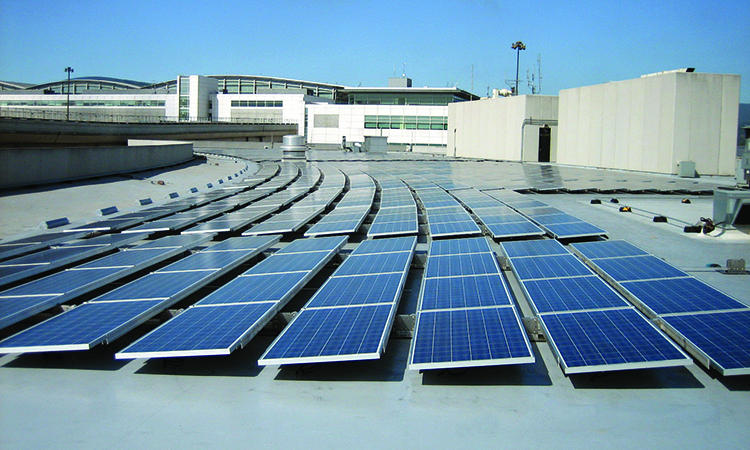

Credit: San Francisco International Airport
Net zero energy and healthy buildings
SFO is proud to be home to the first net zero energy-certified airport building in the world”
SFO is proud to be home to the first net zero energy-certified airport building in the world, but we also apply what we have learned in delivering this facility to our other 17 million square feet of occupied space. We design, construct and operate high performance facilities that leverage passive sources of energy (daylight, heat), maximise efficiency (high performance equipment, implementing commissioning and retro-commissioning processes for new and existing buildings, respectively), are adaptive to emerging climate hazards (sea level rise, increased precipitation and even pandemics) and are all-electric.
Energy efficiency is combined with design for building occupant comfort, using ceiling mounted radiant heating and cooling panels in hold rooms and dynamic glazing to control heat and glare. Airport facilities also combine energy efficiency with improved indoor environments and air quality. These multiple outcomes are not mutually inclusive.
Co-creation by committee: Yes, it works!
Engineers, architects, zero waste and facilities experts meet monthly to review projects and consider enhancements that would exceed green building code requirements”
These net zero energy and healthy environmental measures noted were prioritised by SFO’s interdisciplinary Zero Energy and Resilient Outcomes (ZERO) Committee. This committee was launched in 2016 to invest $100 million in projects across our current $7.8 billion capital improvement Ascent Program and to support the achievement of our Strategic Plan Goals. Engineers, architects, zero waste and facilities experts meet monthly to review projects and consider enhancements that would exceed green building code requirements (which, per the San Francisco Environment code, is at a minimum LEED Gold certification) and help the airport to hit ‘zero’. To date, we have reviewed 41 projects, invested $86 million across 10 of these, and netted dramatic energy use intensity (EUI, measured in kBtu/sq.ft./year) reductions and energy savings over baseline buildings, helping us to curb operational and utility expenses for these new assets. So far, we’ve only addressed 13 per cent of our building stock, but lessons learned are being applied to existing buildings through an emerging retro-commissioning team that we are putting in place while elements of our Capital Improvement Program (CIP) are on hold during the pandemic.
Beyond financial metrics to the triple bottom line
Something we’re taking from our ZERO Committee process and applying to investment decisions across campus is the use of Triple Bottom Line Cost Benefit Analysis (TBL-CBA) by using a web-based online software tool, AutocaseTM. This software allows us to move beyond CapEx/OpEx investments that are based upon first cost to identifying, quantifying and monetising the environmental, social and long-term financial costs and benefits within a total lifetime net present value metric. We used TBL-CBA to analyse and compare net zero energy enhancements, including: dynamic glazing versus clear high-performance glazing; radiant heating/cooling system versus air supplied heating/cooling; and maximising roof area for photovoltaic (PV) panel systems versus the maximum 15 per cent code required PV roof coverage. This tool guided investments on our Harvey Milk Terminal 1 and Courtyard Three Connector/Executive Office Block/Consolidated Operations Center building projects, and it is guiding the evaluation of alternative rate structures for electric vehicle charging across campus.
This tool also helped our ZERO Committee to prioritise measures that expanded the third-party green building rating system certifications that are utilised on our campus. To date, two per cent of our total investment went to health and wellness measures.
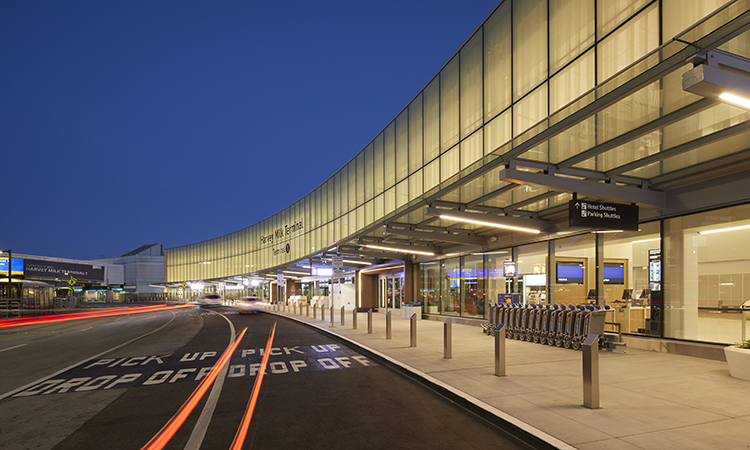

Credit: San Francisco International Airport
Healthy building standards demystified
The design, construction and operation of SFO’s building have focused on the provision of indoor environments that support improved safety, health and wellbeing for passengers and airport/airline/tenant employees. Core strategies included reducing and/or eliminating the sources of indoor pollutants; appropriate HVAC system design and air filtration to dissipate and remove pollutants; the implementation of a building commissioning process; and the use of a well-planned operations and maintenance plan.
The design, construction and operation of SFO’s building have focused on the provision of indoor environments that support improved safety, health and wellbeing for passengers and airport/airline/tenant employees”
Building products, materials, finishes and furnishing were selected based on their low or no formaldehyde and volatile organic compound (VOC) emissions and content. This was done to maintain low indoor VOC concentration and to improve occupant health. The selection of these items also included a review of their Health Product Declarations (HPDs) and Environmental Product Declarations (EPD), with the intent of selecting building products with reduced long-term life cycle planetary impact.
Green Building rating systems were, and continue to be, used to inform SFO’s facilities. Such rating systems include LEED, WELL Building Standard, Fitwel Certification, Living Building Challenge, ParkSmart and Envision. For those less familiar with WELL and FitWel, these rating systems focus on elevating and prioritising the health of the people that occupy our spaces. As building owners, and as an airport who feels a strong sense of responsibility to safeguard our employees and passengers traveling through airport buildings, WELL and FitWel provide a template on how to go further. Using them, we have moved beyond an airport known for yoga rooms and banning plastic water bottles to one that is using evidence and science-based standards to improve areas like air, water, nourishment, thermal comfort, sound, materials, mind and community, as well to prioritise outcomes and impacts that we’re proud to bring to our employees, passengers and campus, such as reduced absenteeism, social equity across vulnerable populations, instilling feelings of wellness, enhanced access to healthy foods, promoting occupant safety and increasing physical activity. While it is important to obtain recognition for the work through these certifications, SFO has benefited from the certification process by incorporating WELL and Fitwel features into policy and the updated SFO Sustainable Planning, Design and Construction Guidelines. SFO’s Harvey Milk Terminal 1 Centre building has already achieved the design phase Fitwel two-star certification (the first airport facility to achieve this award), and the Harvey Milk Terminal 1 Boarding Area B project is pursuing the WELL Standard Certification. Pursuit of both will provide us with the opportunity to evaluate the value of these certifications for future airport facilities
All of which serve as models for work-life-wellness and balance, critical during this time of mental and physical strain for all of us. These programmes, which the ZERO Committee started to pursue as early as 2017, also positioned our campus to respond to COVID-19 via our sustained focus on building and occupant health.
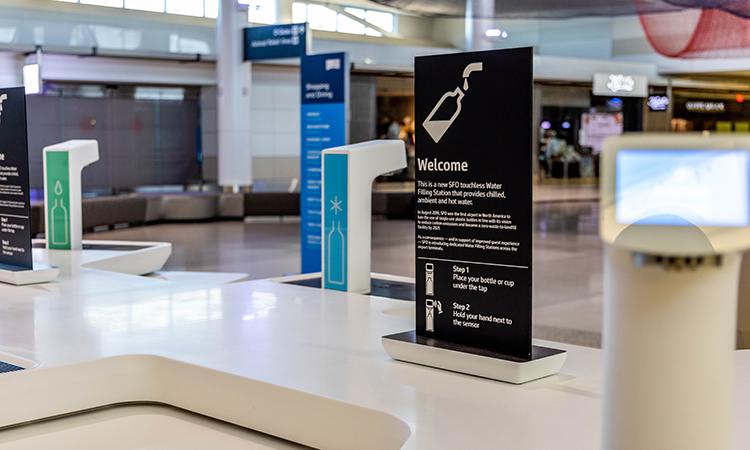

Credit: San Francisco International Airport
Criticality of healthy air in response to COVID-19
In addition to the services and programmes guided by our healthy buildings work, SFO retains its heavy focus on air filtration and good ventilation. Having already executed this work, SFO sustained these best practices among our mechanical systems to continue to filter outdoor and recirculated air to abate the airborne virus and remove particulates during the wildfires. The current standard for outdoor and recirculated air filtration is a combination of MERVE 8 prefilter, MERVE 14 filter, an ultraviolet Photocatalytic Oxidation unit and a 1” bonded particulate structure carbon filter, designed to remove large and fine particulate matter (PM10 and PM2.5), formaldehyde, VOCs, odour from jet fuel and aerosolised COVID-19 particles.
We spend over 90 per cent of our time indoors, including our time at SFO, so, simply put, we really need to care about our air”
We spend over 90 per cent of our time indoors, including our time at SFO, so, simply put, we really need to care about our air. Our incredible mechanical maintenance team served a huge role in our pandemic response and shared our approach, grounded by ACI guidelines and ASHRAE Standards, as lead contributors to an ACI whitepaper sharing best practice ventilation guidance for airports globally. Further contributing to the health of our air is SFO’s award-winning custodial team, who are long standing advocates for using green cleaning products, which we continue to use as part of our COVID-19 cleaning protocols. This facilities group selects less chemically intensive, ‘SF-Approved’ products because they are healthier. Using green cleaning products can reduce the chance of developing asthma; they’re safer; green cleaners are not corrosive; they meet strict standards regarding inhalation toxicity, combustibility and skin absorption; they are cost-competitive; they reduce risk during spills; and they clean our air, so much so that you can smell the difference!
Firmly zero footprint-focused
Beyond improvements in energy and health, our airport remains focused on reducing the footprint of our passengers’ origins and destinations. As we look to achieve a 50 per cent carbon emissions reduction from baseline in 2021, we are posturing the campus to achieve 92 per cent reduction before 2030 through the activation of an all-electric central plant, now undergoing technical review and design development. The TBL-CBA indicated that this proposed all-electric central plan would be cost neutral and could even save operational costs when compared to our current gas-powered plant.
As we look to achieve a 50 per cent carbon emissions reduction from baseline in 2021, we are posturing the campus to achieve 92 per cent reduction before 2030″
We also expect to reduce transport emissions through the activation of an all-electric bus fleet (of which, eight of 14 were purchased in 2020), procurement of 65 new light duty EV fleet/carpool vehicles and the deactivation of CNG fleet reserves as we extend our GHG-free Airtrain.
Like our airport peers, we always lead by example first, but also make sure that we expand these amenities and opportunities for environmental gains to our passengers and tenants. To that end, we are planning for 2,000 new load-managed EV chargers, including Level 3/DC fast chargers to serve our ridesharing/hailing companies that will now operate with an incentive-based permit to fuel switch. We continue to encourage and incentivise our airlines – 70 per cent of which have active commitments to uplift sustainable aviation fuel (SAF) from SFO, which now has active deliveries from two producers via pipeline and over the rack.
Beyond transport, we continue to streamline the materials that are used on our campus by banning the sale of all plastic beverage containers and ensuring healthy third-party certified compostable products are used for all food ware and accessories. We are also focused on zero waste, including reducing embodied carbon across our building projects both through a high diversion rate of over 90 per cent of construction and demolition debris from landfill due to onsite sorting, but also in material sourcing that prioritised low-embodied carbon steel and low-embodied and high sequestered carbon concrete.
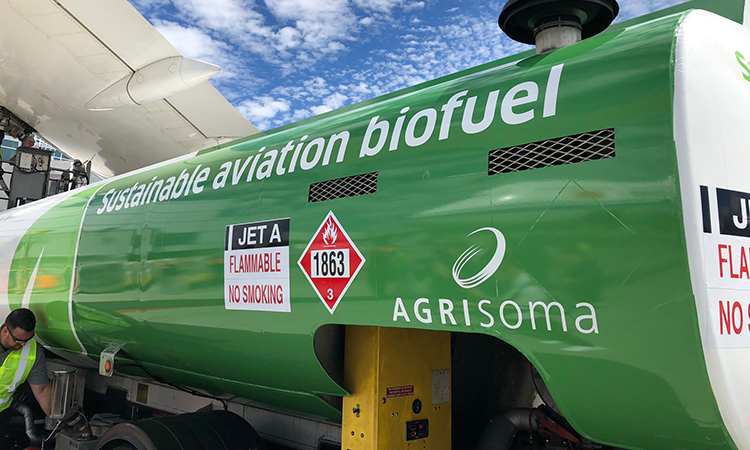

Credit: San Francisco International Airport
Conclusion
In closing, what was once a ‘moonshot’ for our campus – achieving ‘zero’ – has now become the playbook for pandemic response and economic recovery. It is adapted to our new operational needs, and has in many ways inspired and ensured our business continuity. SFO has taken an integrated holistic approach to developing sustainability policies and integrating those policies through a close collaboration with its stakeholders and design and construction partners. The results include various certifications and awards. The results also include reduced energy and water use, reduced carbon emission and healthier environments, and this addresses SFO’s approach to improved human and planetary health. These triple bottom wins have helped SFO to recover and will, ultimately, ensure our resilience from future crises and/or climatic events.


Cooke also serves on the Board of Directors of the Institute for Sustainable Infrastructure (ISI) and the ACI World Environment Standing Committee (WeNSC). Prior to SFO, she was the City of Cupertino’s first Sustainability Manager and Deputy City Manager, where she drafted the city’s first Climate Action Plan and launched a community choice energy programme (Silicon Valley Clean Energy). Cooke also worked on the climate teams at the Conservation Law Foundation, NASA’s Goddard Institute of Space Studies and the National Park Service. She is a LEED AP and holds a MPA from Columbia University and a BS and BA from the University of Massachusetts.


Bernheim has a record of designing and implementing a holistic approach and process to sustainability, contributing to improving human health, comfort and wellness in the built environment and global health. He is currently the Healthy & Resilient Buildings Program Manager – Planning, Design & Construction at San Francisco International Airport. Bernheim has a history of public service, having served as a member of the U.S. Green Building Council (USGBC) Board of Directors in diverse capacities and on key committees since 2003.
Join our free webinar: Revolutionising India’s travel experience through the Digi Yatra biometric programme.
Air travel is booming, and airports worldwide need to move passengers faster and more efficiently. Join the Digi Yatra Foundation and IDEMIA to discover how this groundbreaking initiative has already enabled over 60 million seamless domestic journeys using biometric identity management.
Date: 16 Dec | Time: 09:00 GMT
rEGISTER NOW TO SECURE YOUR SPOT
Can’t attend live? No worries – register to receive the recording post-event.
Related topics
Airport construction and design, Airside operations, Cleaner, Greener Airports: Making Aviation More Sustainable Series, COVID-19, Emissions, Funding and finance, Machinery, Safety, Sustainability, Sustainable Aviation Fuel (SAF), Sustainable development, Terminal operations, Workforce




